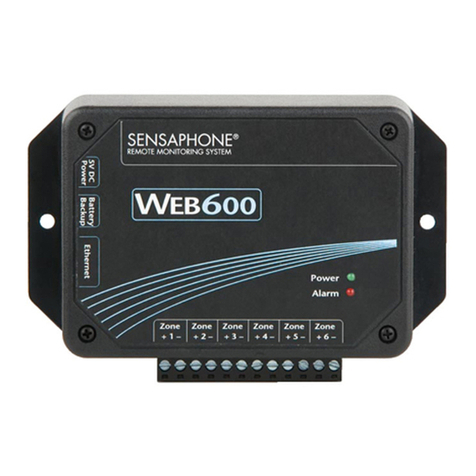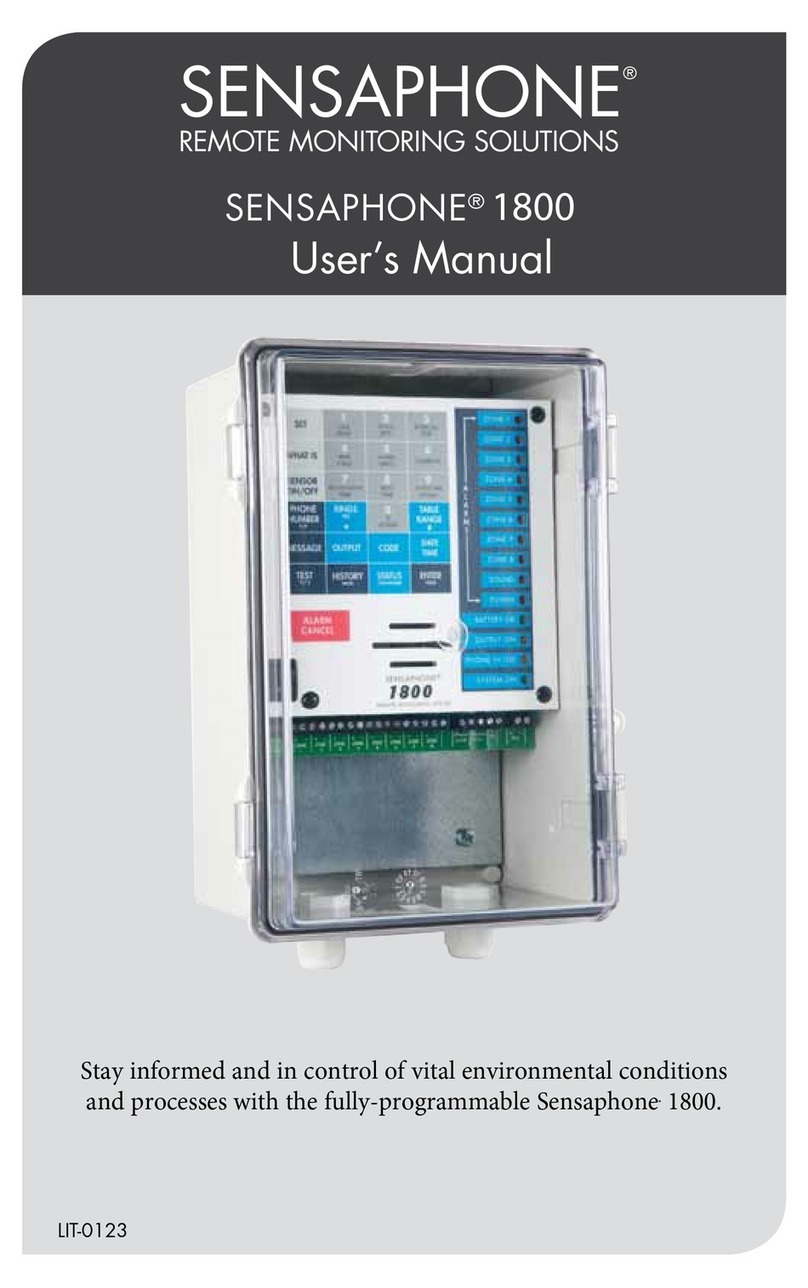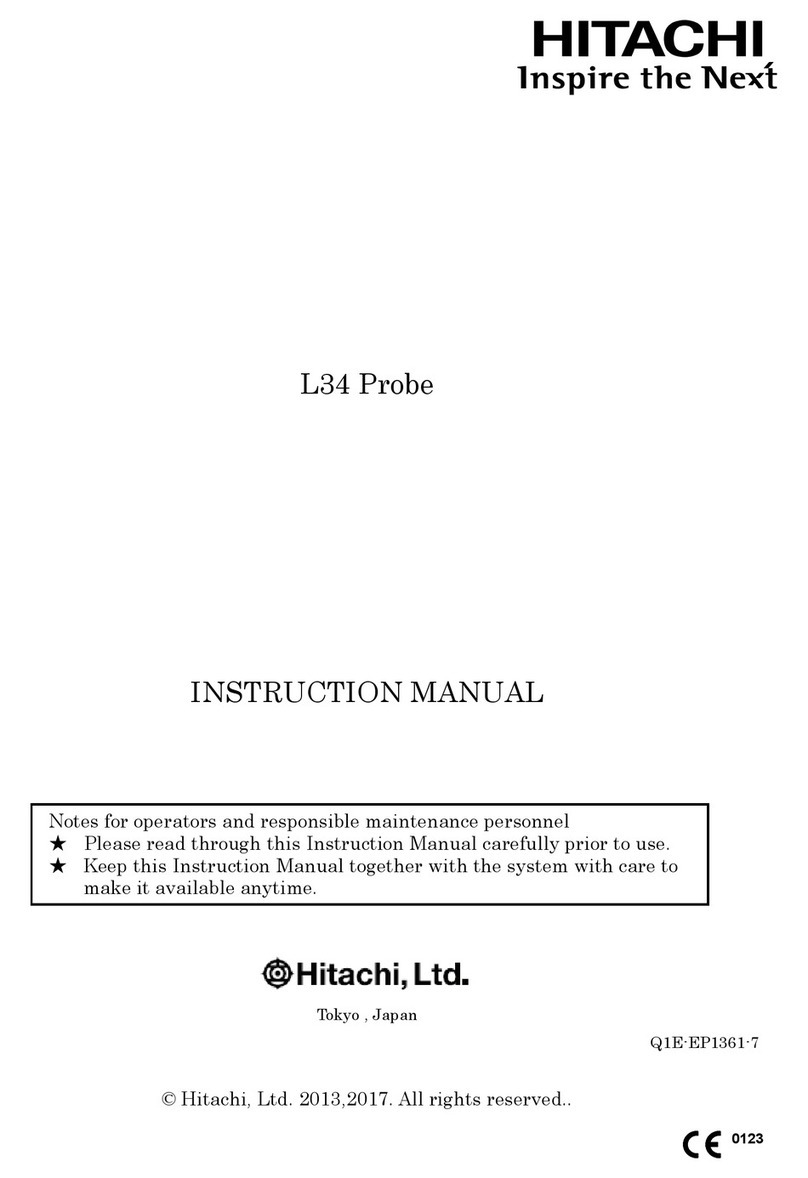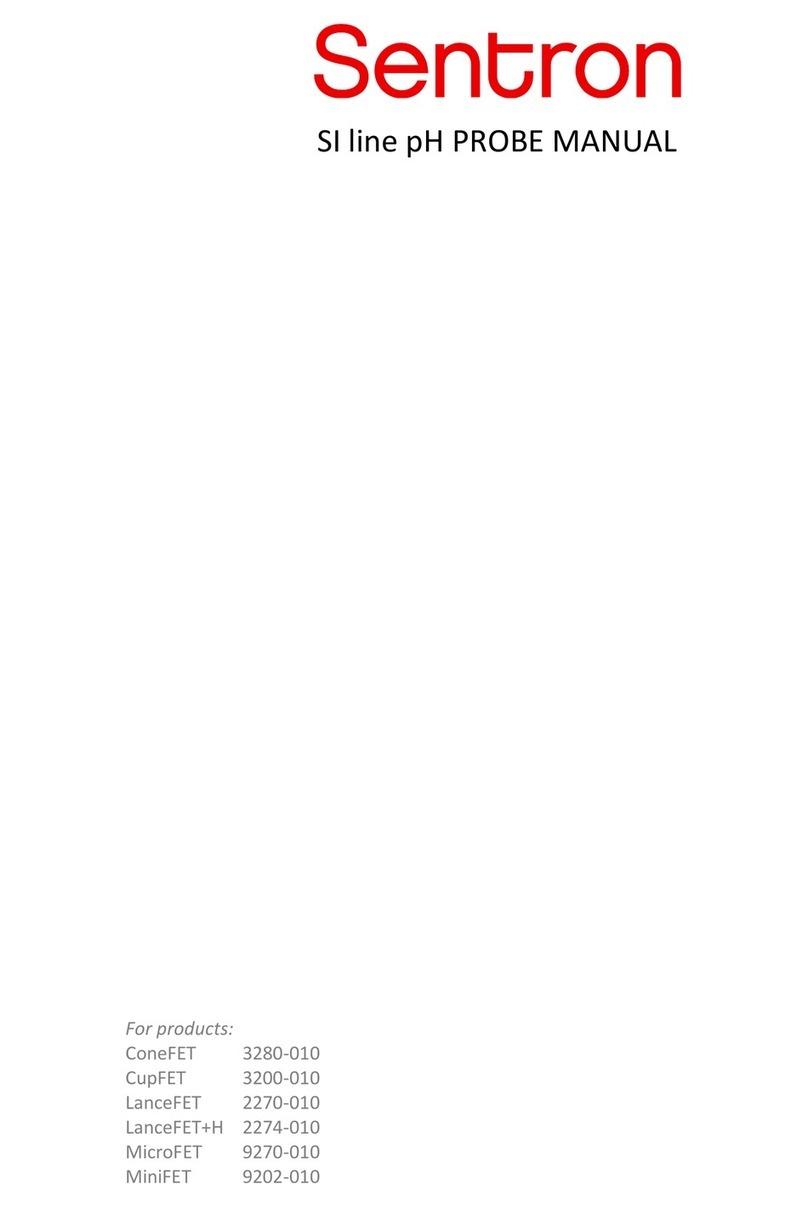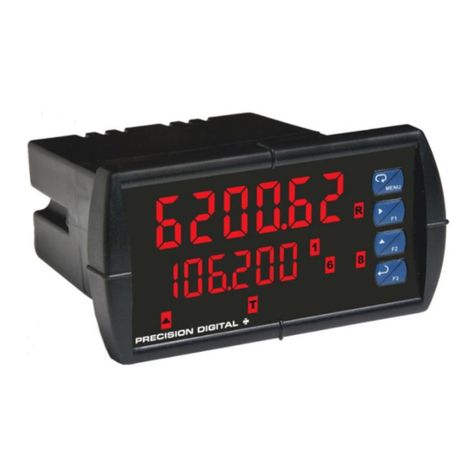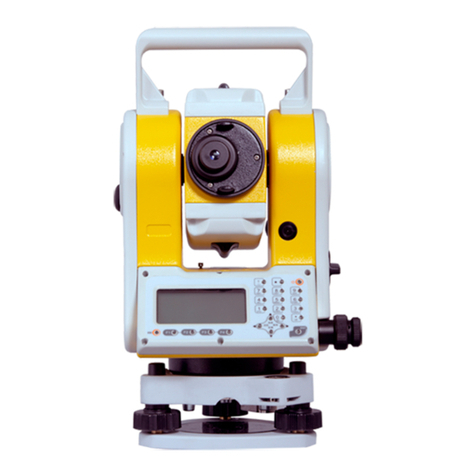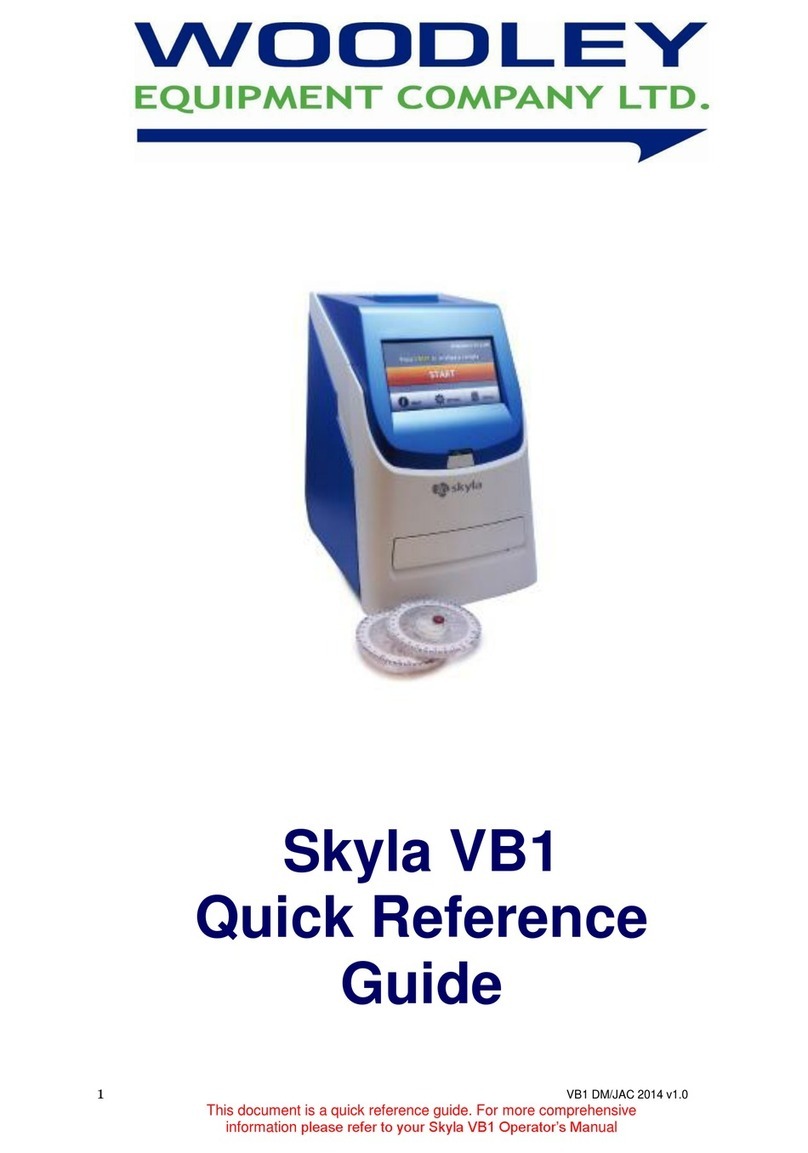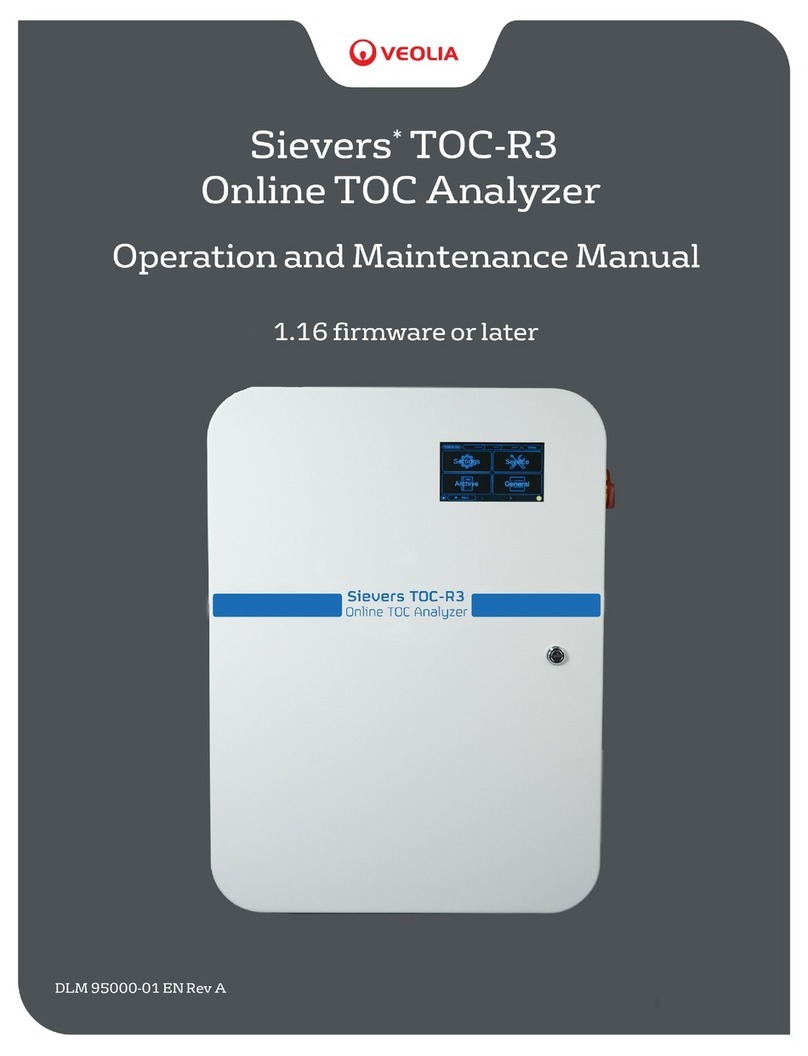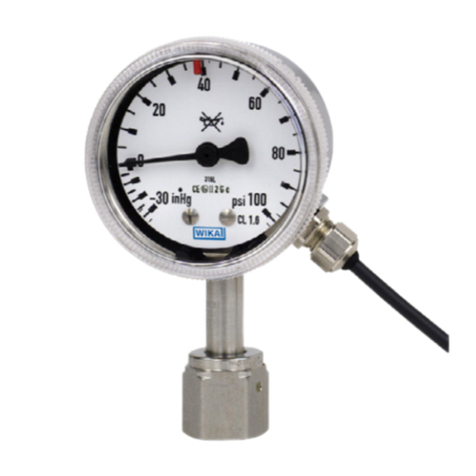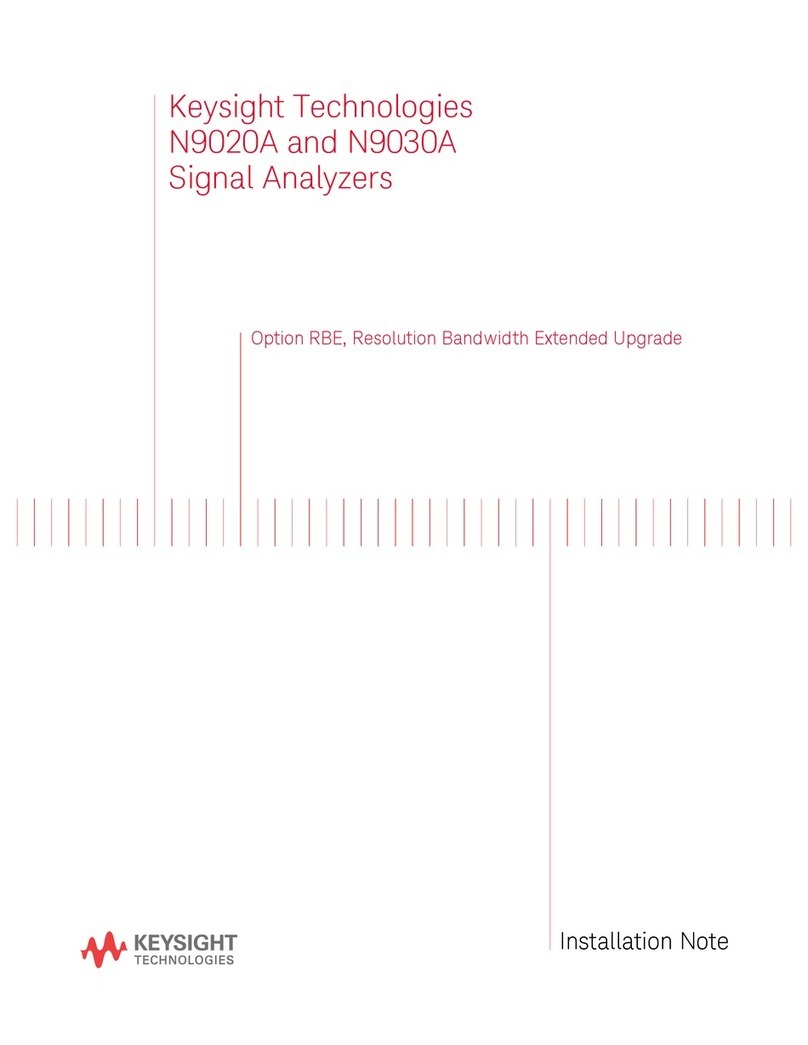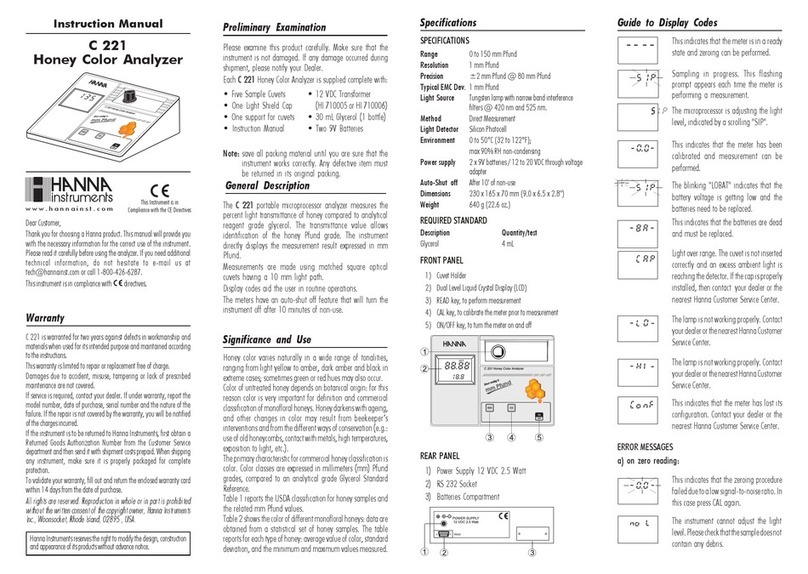Sensaphone WEB600 User manual

WEB600
USER’S MANUAL
VERSION 1.2.8
- -*" Á
,"/Ê" /", Ê-"1/" -

2
WEB600 User’s Manual
Every effort has been made to ensure that the information in this document is complete, accurate
and up-to-date. Sensaphone assumes no responsibility for the results of errors beyond its control.
Sensaphone also cannot guarantee that changes in equipment made by other manufacturers, and referred
to in this manual, will not affect the applicability of the information in this manual.
Copyright © 2009 by SENSAPHONE®
First Edition, version 1.2.8, January 2011
Written and produced by SENSAPHONE®.
Please address comments on this publication to:
SENSAPHONE®
901 Tryens Road
Aston, PA 19014

3
Important Safety Instructions
Your Web600 has been carefully designed to give you years of safe, reliable performance. As with all
electrical equipment, however, there are a few basic precautions you should take to avoid hurting your-
self or damaging the unit:
s2EADTHEINSTALLATIONANDOPERATINGINSTRUCTIONSINTHISMANUALCAREFULLY"ESURETOSAVEITFORFUTURE
reference.
s2EADANDFOLLOWALLWARNINGANDINSTRUCTIONLABELSONTHEPRODUCTITSELF
s4OPROTECTTHE7EBFROMOVERHEATINGMAKESUREALLOPENINGSONTHEUNITARENOTBLOCKED$ONOT
place on or near a heat source, such as a radiator or heat register.
s$ONOTUSEYOUR7EBNEARWATERORSPILLLIQUIDOFANYKINDINTOIT
s"ECERTAINTHATYOURPOWERSOURCEMATCHESTHERATINGINTHESPECIFICATIONSOFTHISMANUAL)FYOURE
not sure of the type of power supply to your facility, consult your dealer or local power company.
s$ONOTALLOWANYTHINGTORESTONTHEPOWERCORD$ONOTLOCATETHISPRODUCTWHERETHECORDWILLBE
abused by persons walking on it.
s$ONOTOVERLOADWALLOUTLETSANDEXTENSIONCORDSASTHISCANRESULTINTHERISKOFFIREORELECTRIC
shock.
s.EVERPUSHOBJECTSOFANYKINDINTOTHISPRODUCTTHROUGHVENTILATIONHOLESASTHEYMAYTOUCH
dangerous voltage points or short out parts that could result in a risk of fire or electric shock.
s4OREDUCETHERISKOFELECTRICSHOCKDONOTDISASSEMBLETHISPRODUCTBUTRETURNITTO3ENSAPHONE
Customer Service, or another approved repair facility, when any service or repair work is required.
/PENINGORREMOVINGCOVERSMAYEXPOSEYOUTODANGEROUSVOLTAGESOROTHERRISKS)NCORRECTREASSEMBLY
can cause electric shock when the unit is subsequently used.
s)FANYTHINGHAPPENSTHATINDICATESTHATYOUR7EBISNOTWORKINGPROPERLYORHASBEENDAMAGED
unplug it immediately and follow the procedures in the manual for having it serviced. Return the unit
for servicing under the following conditions:
1. The power cord or plug is frayed or damaged.
,IQUIDHASBEENSPILLEDINTOTHEPRODUCTORITHASBEENEXPOSEDTOWATER
3. The unit has been dropped, or the enclosure is damaged.
4HEUNITDOESNTFUNCTIONNORMALLYWHENYOUREFOLLOWINGTHEOPERATINGINSTRUCTIONS
s4OREDUCETHERISKOFFIREORINJURYTOPERSONSREADANDFOLLOWTHESEINSTRUCTIONS
1. Use only the specified type and size battery.
$ONOTDISPOSEOFTHEBATTERYINAFIRE4HECELLMAYEXPLODE#HECKWITHLOCALCODESFOR
possible special disposal instructions.
$ONOTOPENORMUTILATEBATTERIES2ELEASEDELECTROLYTEISCORROSIVEANDMAYCAUSEDAMAGE
TOTHEEYESORSKIN)TMAYBETOXICIFSWALLOWED
%XERCISECAREINHANDLINGBATTERIESINORDERNOTTOSHORTTHEBATTERYWITHCONDUCTING
materials such as rings, bracelets, and keys. The battery or conductor may overheat and cause
burns.
5. Remove main power connections before replacing the battery.

4
WEB600 User’s Manual
FCC Requirements
Part 15: This equipment has been tested and found to comply with the limits for a Class A digital device,
pursuant to Part 15 of the FCC Rules. These limits are designed to provide reasonable protection against
harmful interference when the equipment is operated in a commercial environment. This equipment
generates, uses and can radiate radio frequency energy and, if not installed and used in accordance with
the instructions, may cause harmful interference to radio communications. Operation of this equipment
in a residential area is likely to cause harmful interference in which case the user will be required to cor-
rect the interference at his own expense.

5
1 YEAR LIMITED WARRANTY
0,%!3%2%!$4()37!22!.49#!2%&5,,9"%&/2%53).'4(%02/$5#4
4()3,)-)4%$7!22!.49#/.4!).33%.3!0(/.%334!.$!2$4%2-3!.$#/.$)4)/.37(%2%0%2-)44%$"94(%
!00,)#!",%,!7"9+%%0).'9/523%.3!0(/.%02/$5#4"%9/.$4()249$!93!&4%24(%$!4%/&$%,)6%299/5
&5,,9!##%044(%4%2-3!.$#/.$)4)/.33%4&/24().4()3,)-)4%$7!22!.49
).!$$)4)/.7(%2%0%2-)44%$"94(%!00,)#!",%,!79/52).34!,,!4)/.!.$/253%/&4(%02/$5#4#/.34)454%3
&5,,!##%04!.#%/&4(%4%2-3!.$#/.$)4)/.3/&4()3,)-)4%$7!22!.49(%2%).!&4%22%&%22%$4/!3h,)-)4%$
7!22!.49/27!22!.49v)&9/5$/./4!'2%%4/4(%4%2-3!.$#/.$)4)/.34()37!22!.49).#,5$).'!.9
,)-)4!4)/.3/&7!22!.49).$%-.)&)#!4)/.4%2-3/2,)-)4!4)/./&,)!"),)494(%.9/53(/5,$./453%4(%02/$5#4
!.$3(/5,$2%452.)44/4(%3%,,%2&/2!2%&5.$/&4(%052#(!3%02)#%4(%,!7-!96!29"9*52)3$)#4)/.!34/
4(%!00,)#!"),)49/&9/52).34!,,!4)/./253%!#45!,,9#/.34)454).'!##%04!.#%/&4(%4%2-3!.$#/.$)4)/.3
(%2%).!.$!34/4(%!00,)#!"),)49/&!.9,)-)4!4)/./&7!22!.49).$%-.)&)#!4)/.4%2-3/2,)-)4!4)/.3/&
,)!"),)49
1. WARRANTOR).4()37!22!.497!22!.4/23(!,,-%!.h$%!,%2$)342)"54/2!.$/2-!.5&!#452%2v
2. ELEMENTS OF WARRANTY4()302/$5#4)37!22!.4%$4/"%&2%%&2/-$%&%#43).-!4%2)!,3!.$#2!&43-!.3()0
7)4(/.,94(%,)-)4!4)/.3!.$%8#,53)/.33%4/54"%,/7
3. WARRANTY AND REMEDY/.%9%!27!22!.49).4(%%6%.44(!44(%02/$5#4$/%3./4#/.&/2-4/4()3
7!22!.49!4!.94)-%$52).'4(%4)-%/&/.%9%!2&2/-/2)').!,052#(!3%7!22!.4/27),,2%0!)24(%$%&%#4
!.$2%452.)44/9/5!4./#(!2'%
4()37!22!.493(!,,4%2-).!4%!.$"%/&./&524(%2%&&%#4!44(%4)-%4(%02/$5#4)3$!-!'%$"9
%842!.%/53#!53%35#(!3&)2%7!4%2,)'(4.).'%4#/2./4-!).4!).%$!32%!3/.!",%!.$.%#%33!29/2
-/$)&)%$/2)-02/0%2,9).34!,,%$/2-)353%$/22%0!)2%$/23%26)#%$"93/-%/.%/4(%24(!.
7!22!.4/23!54(/2):%$0%23/..%,/23/-%/.%%802%33,9!54(/2):%$"97!22!.4/234/-!+%35#(3%26)#%
/22%0!)2353%$).!-!..%2/20520/3%&/27()#(4(%02/$5#47!3./4).4%.$%$/23/,$"9/2)').!,
PURCHASER.
,)-)4%$7!22!.49,)-)4!4)/./&$!-!'%3!.$$)3#,!)-%2/&,)!"),)49&/2$!-!'%34(%7!22!.4/23/",)'!4)/.
5.$%24()37!22!.49)3,)-)4%$4/2%0!)2/22%0,!#%-%.4/&4(%02/$5#4!44(%7!22!.4/23/04)/.!34/
2%0!)2/22%0,!#%-%.4)../%6%.43(!,,7!22!.4/23"%,)!",%/22%30/.3)",%&/20!9-%.4/&!.9).#)$%.4!,
#/.3%15%.4)!,30%#)!,!.$/205.)4)6%$!-!'%3/&!.9+).$).#,5$).'"54./4,)-)4%$4/!.9,!"/2#/343
02/$5#4#/343,/342%6%.5%"53).%33).4%22504)/.,/33%3,/3402/&)43,/33/&"53).%33,/33/&$!4!/2
).&/2-!4)/./2&).!.#)!,,/33&/2#,!)-3/&!.9.!452%).#,5$).'"54./4,)-)4%$4/#,!)-3).#/.42!#4
"2%!#(/&7!22!.49/24/24!.$7(%4(%2/2./4#!53%$"97!22!.4/23.%',)'%.#%).4(%%6%.44(!4)4)3
$%4%2-).%$).!.9!$*5$)#!4)/.4(!44(%,)-)4%$7!22!.4)%3/&2%0!)2/22%0,!#%-%.4!2%).!00,)#!",%4(%.
4(%052#(!3%233/,%2%-%$93(!,,"%0!9-%.44/4(%052#(!3%2/&4(%/2)').!,#/34/&4(%02/$5#4!.$).
./%6%.43(!,,7!22!.4/23"%,)!",%/22%30/.3)",%&/20!9-%.4/&!.9).#)$%.4!,#/.3%15%.4)!,30%#)!,
!.$/205.)4)6%$!-!'%3/&!.9+).$).#,5$).'"54./4,)-)4%$4/!.9,/342%6%.5%"53).%33).4%22504)/.
,/33%3,/3402/&)43,/33/&"53).%33,/33/&$!4!/2).&/2-!4)/./2&).!.#)!,,/33&/2#,!)-3/&!.9.!452%
).#,5$).'"54./4,)-)4%$4/#,!)-3).#/.42!#4"2%!#(/&7!22!.49/24/24!.$7(%4(%2/2./4#!53%$"9
7!22!.4/23.%',)'%.#%
7)4(/547!)6).'!.902/6)3)/.).4()3,)-)4%$7!22!.49)&!#)2#5-34!.#%!2)3%37(%2%7!22!.4/23!2%&/5.$
4/"%,)!",%&/2!.9,/33/2$!-!'%!2)3).'/54/&-)34!+%3.%',)'%.#%/-)33)/.3).4%22504)/.3$%,!93
%22/23/2$%&%#43).7!22!.4/2302/$5#43/23%26)#%335#(,)!"),)493(!,,./4%8#%%$4(%4/4!,!-/5.40!)$
"94(%#534/-%2&/27!22!.4/2302/$5#4!.$3%26)#%3/27()#(%6%2)3'2%!4%29/5(%2%"92%,%!3%
7!22!.4/23&2/-!.9!.$!,,/",)'!4)/.3,)!"),)4)%3!.$#,!)-3).%8#%33/&4()3,)-)4!4)/.
).$%-.)&)#!4)/.!.$#/6%.!.4./44/35%9/57),,).$%-.)&9$%&%.$!.$(/,$(!2-,%337!22!.4/234(%)2
/7.%23$)2%#4/23/&&)#%23%-0,/9%%3!'%.433500,)%23/2!&&),)!4%$#/-0!.)%3!'!).34!.9!.$!,,#,!)-3
$%-!.$3/2!#4)/.3"!3%$50/.!.9,/33%3,)!"),)4)%3$!-!'%3/2#/343).#,5$).'"54./4,)-)4%$4/$!-!'%3
4(!4!2%$)2%#4/2).$)2%#4).#)$%.4!,30%#)!,/2#/.3%15%.4)!,!.$).#,5$).'!44/2.%93&%%3!.$,%'!,
#/3434(!4-!92%35,4&2/-4(%).34!,,!4)/./0%2!4)/.53%/&/2).!"),)494/53%7!22!.4/2302/$5#43!.$
3%26)#%3/2&2/-4(%&!),52%/&4(%7!22!.4/233934%-4/2%0/24!')6%.%6%.4/2#/.$)4)/.7(%4(%2/2./4
#!53%$"97!22!.4/23.%',)'%.#%
9/5!'2%%4/2%,%!3%7!)6%$)3#(!2'%!.$#/6%.!.4./44/35%7!22!.4/234(%)2/7.%23$)2%#4/23/&&)#%23
%-0,/9%%3!'%.433500,)%23/2!&&),)!4%$#/-0!.)%3&/2!.9!.$!,,,)!"),)4)%30/4%.4)!,,9!2)3).'&2/-
!.9#,!)-$%-!.$/2!#4)/."!3%$50/.!.9,/33%3,)!"),)4)%3$!-!'%3/2#/343).#,5$).'"54./4,)-)4%$
4/$!-!'%34(!4!2%$)2%#4/2).$)2%#4).#)$%.4!,30%#)!,/2#/.3%15%.4)!,!.$).#,5$).'!44/2.%93&%%3
!.$,%'!,#/3434(!4-!92%35,4&2/-4(%).34!,,!4)/./0%2!4)/.53%/&/2).!"),)494/53%7!22!.4/23
02/$5#43!.$3%26)#%3/2&2/-4(%&!),52%/&4(%7!22!.4/233934%-4/2%0/24!')6%.%6%.4/2#/.$)4)/.
7(%4(%2/2./4#!53%$"97!22!.4/23.%',)'%.#%%8#%04!3.%#%33!294/%.&/2#%4(%%802%334%2-3/&4()3
,)-)4%$7!22!.49
%8#,53)6%7!22!.494(%,)-)4%$7!22!.49/27!22!.4)%3$%3#2)"%$(%2%).#/.34)454%4(%3/,%7!22!.49
/27!22!.4)%34/4(%052#(!3%2!,,)-0,)%$7!22!.4)%3!2%%802%33,9$)3#,!)-%$).#,5$).'4(%7!22!.49
/&-%2#(!.4!"),)49!.$4(%7!22!.49/&&)4.%33&/2!0!24)#5,!253%!.$4(%7!22!.49/&&)4.%33&/2!

6
WEB600 User’s Manual
0!24)#5,!20520/3%!.$4(%7!22!.49/&./.).&2).'%-%.4!.$/2!.97!22!.49!2)3).'&2/-!#/523%/&
$%!,).'53!'%/242!$%02!#4)#%
)4-534"%#,%!24(!44(%7!22!.4/23!2%./4).352).'9/5202%-)3%3/2"53).%33/2'5!2!.4%%).'4(!44(%2%
7),,./4"%$!-!'%4/9/520%23/./202/0%249/2"53).%33)&9/553%4()302/$5#49/53(/5,$-!).4!).
).352!.#%#/6%2!'%35&&)#)%.44/02/6)$%#/-0%.3!4)/.&/2!.9,/33$!-!'%/2%80%.3%4(!4-!9!2)3%).
#/..%#4)/.7)4(4(%53%/&02/$5#43/23%26)#%3%6%.)&#!53%$"97!22!.4/23.%',)'%.#%4(%7!22!.4/23
!335-%./,)!"),)49&/2).34!,,!4)/./&4(%02/$5#4!.$/2).4%22504)/.3/&4(%3%26)#%$5%4/342)+%32)/43
&,//$3&)2%!.$/2!.9#!53%"%9/.$3%,,%23#/.42/,&524(%235"*%#44/4(%,)-)4!4)/.3%802%33%$).!.9
,)#%.3%!'2%%-%.4/2/4(%2!'2%%-%.402/6)$%$"97!22!.4/234/052#(!3%2
4(%!'2%%-%.4"%47%%.4(%7!22!.4/23!.$4(%052#(!3%2).#,5$).'"54./4,)-)4%$4/4(%4%2-3!.$
#/.$)4)/.3(%2%).3(!,,./4"%'/6%2.%$"94(%#/.6%.4)/.&/24(%).4%2.!4)/.!,3!,%/&'//$37(%2%
!00,)#!",%4(%5.)&/2-#/--%2#)!,#/$%!3!$/04%$"94(%34!4%/&$%,!7!2%3(!,,!00,9
4. PROCEDURE FOR OBTAINING PERFORMANCE OF WARRANTY).4(%%6%.44(!44(%02/$5#4$/%3./4#/.&/2-
4/4()37!22!.494(%02/$5#43(/5,$"%3()00%$/2$%,)6%2%$&2%)'(402%0!)$4/!7!22!.4/27)4(%6)$%.#%/&
/2)').!,052#(!3%
5. LEGAL REMEDIES AND DISCLAIMER3/-%*52)3$)#4)/.3-!9./4!,,/7/2-!90,!#%,)-)4350/.4(%
%8#,53)/.!.$/2,)-)4!4)/./&)-0,)%$7!22!.4)%3).#)$%.4!,$!-!'%3!.$/2#/.3%15%.4)!,$!-!'%3
&/23/-%490%3/&'//$3/202/$5#433/,$4/#/.35-%23!.$/24(%53%/&).$%-.)&)#!4)/.4%2-34(534(%
%8#,53)/.3).$%-.)&)#!4)/.4%2-3!.$,)-)4!4)/.33%4/54!"/6%-!9./4!00,9/2-!9"%,)-)4%$).4(%)2
!00,)#!4)/.4/9/5)&4(%)-0,)%$7!22!.4)%3#!../4"%%8#,5$%$!.$4(%!00,)#!",%,!70%2-)43,)-)4).'
4(%$52!4)/./&)-0,)%$7!22!.4)%34(%.4(%)-0,)%$7!22!.4)%3(%2%).!2%4/"%,)-)4%$4/4(%3!-%$52!4)/.
!34(%!00,)#!",%72)44%.7!22!.49/27!22!.4)%3(%2%).4(%7!22!.49/27!22!.4)%3(%2%).-!9')6%
9/530%#)&)#,%'!,2)'(434(!47),,$%0%.$50/.4(%!00,)#!",%,!79/5-!9!,3/(!6%/4(%2,%'!,2)'(43
$%0%.$).'50/.4(%,!7).9/52*52)3$)#4)/.
6. CHOICE OF FORUM AND CHOICE OF LAW).4(%%6%.44(!4!$)3054%!2)3%3/54/&/2).#/..%#4)/.7)4(4()3
,)-)4%$7!22!.494(%.!.9#,!)-3/235)43/&!.9+).$#/.#%2.).'35#($)3054%33(!,,/.,9!.$%8#,53)6%,9
"%"2/5'(4).%)4(%24(%#/524/&#/--/.0,%!3/&$%,!7!2%#/5.490%..39,6!.)!/24(%5.)4%$34!4%3
$)342)#4#/524&/24(%%!34%2.$)342)#4/&0%..39,6!.)!
2%'!2$,%33/&4(%0,!#%/&#/.42!#4).'/20%2&/2-!.#%4()3,)-)4%$7!22!.49!.$!,,15%34)/.32%,!4).'4/
)436!,)$)49).4%202%4!4)/.0%2&/2-!.#%!.$%.&/2#%-%.43(!,,"%'/6%2.%$"9!.$#/.3425%$).!##/2$!.#%
7)4(4(%,!73/&4(%34!4%/&$%,!7!2%7)4(/542%'!2$4/4(%02).#)0,%3/&#/.&,)#43/&,!7
%FFECTIVEDATE
0(/.%4)#3).#DBA3%.3!0(/.%
901 Tryens Road
Aston, PA 19014
Phone: 610.558.2700 Fax: 610.558.0222
www.sensaphone.com

7
Table of Contents
TABLE OF CONTENTS
CHAPTER 1: INSTALLATION ..........................9
INTRODUCTION .................................................9
FEATURES ...............................................................................9
TECHNICAL SUPPORT ......................................................................9
ABOUT THIS MANUAL ............................................9
INSTALLATION AND CONFIGURATION ...............................10
PHYSICAL DESCRIPTION ...................................................................10
LAYOUT ...............................................................................10
RJ-45 10/100BASE-T ETHERNET PORT.........................................................10
SENSOR INPUTS .........................................................................10
POWER ON LED (GREEN) ..................................................................10
ALARM LED (RED) ........................................................................10
INSTALLATION .................................................11
PARTS REQUIRED ........................................................................11
OPERATING ENVIRONMENT................................................................11
WALL MOUNT INSTALLATION ...............................................................11
TABLETOP INSTALLATION ..................................................................11
CONNECTING SENSORS ..........................................12
GENERAL WIRING CONSIDERATIONS ........................................................12
NORMALLY OPEN / NORMALLY CLOSED DRY CONTACTS .........................................13
2.8K/10K TEMPERATURE SENSORS...........................................................13
4–20MA CURRENT LOOP TRANSDUCERS ......................................................14
BATTERY BACKUP (OPTIONAL) ..............................................................14
NETWORK CONFIGURATION ......................................15
NETWORK PARAMETER DESCRIPTIONS ...............................16
INSTALLING THE SENSAPHONE LOCATOR SOFTWARE ............................................17
USING THE SENSAPHONE LOCATOR SOFTWARE ................................................17
RESETTING THE WEB600 TO FACTORY DEFAULT SETTINGS .........................................18
CHAPTER 2: SYSTEM CONFIGURATION ................19
INTRODUCTION ................................................19
SETUP MENU ...........................................................................19
SYSTEM ...............................................................................19
NETWORK .............................................................................20
SMTP .................................................................................21
SNMP .................................................................................21
MODBUS® .............................................................................22
ADMIN ................................................................................22

8
WEB600 User’s Manual
CHAPTER 3: ZONE PROGRAMMING ..................23
CHAPTER 4: USER PROGRAMMING ...................27
CONTACT PROGRAMMING ................................................................28
E-MAIL PROGRAMMING ..................................................................28
SMS-TEXT MESSAGE PROGRAMMING ........................................................29
SNMP TRAP ............................................................................29
CHAPTER 5: HISTORY .............................31
EVENT LOG QUERY ......................................................................31
DATALOG QUERY ........................................................................31
CHAPTER 6: OPERATION ...........................33
ALARM PROCESSING .....................................................................33
RETURN-TO-NORMAL ALARM MESSAGES......................................................34
NETWORK SERVICE DISRUPTION ............................................................34
APPENDIX A: WEEKLY TESTING PROCEDURE ............35
APPENDIX B: ACCESSORIES.........................37
APPENDIX C: MODBUS® SPECIFICATIONS ..............39
MODBUS® NOTES ..............................................41
APPENDIX D: SPECIFICATIONS.......................45
ALERT ZONES ...........................................................................45
DATA LOGGING .........................................................................45
COMMUNICATION TYPES: .................................................................45
POWER SUPPLY..........................................................................45
ENVIRONMENTAL........................................................................46
PHYSICAL ..............................................................................46
APPENDIX E: OID INFORMATION ....................47
WEB 600 OID INFO ......................................................................47
ZONE INFORMATION.....................................................................47
DATALOGGER...........................................................................52
GAUGE SETTINGS .......................................................................53
PROFILE INFORMATION ...................................................................53
APPENDIX F: THERMISTORS ........................55
2.8K THERMISTOR DATA ...................................................................55
10K THERMISTOR DATA ...................................................................55
APPENDIX G: RETURNING THE UNIT FOR REPAIR.........57
APPENDIX H: TEST LOG ...........................59

9
Chapter 1: Installation
CHAPTER 1: INSTALLATION
INTRODUCTION
Congratulations on your purchase of the Sensaphone Web600 Monitoring System. The system is designed to
be an easy, cost–effective, network–based monitoring system to notify you when equipment or conditions go
awry. The internet browser–based programming makes the device easy to use from any computer on your
network. Monitored conditions can include temperature, humidity levels, line voltage, leak detection, UPS
systems, and more. The system allows multiple users to be notified immediately of any detected problems.
Notification can occur via e–mail, SMS (text message) or SNMP trap. An optional battery backup system
(FGD-W610-B) insures that the unit will continue to run if main power fails.
FEATURES
The Web600 includes the following key features:
QSix sensor inputs to monitor environmental conditions and/or alarm contacts from other computer
equipment such as UPS systems.
Q10/100BASE-T Ethernet port.
QOptional battery backup for uninterrupted performance.
QCompact design allows wall-mount or tabletop installation.
QEmbedded web page to program and manage your Web600 system.
QNotification via e–mail, SMS (text message) or SNMP trap.
TECHNICAL SUPPORT
If any questions arise upon installation or operation of the Web600, please contact the Sensaphone
Technical Service Department at 610.558.2700 and have the following information available:
t%BUFPGQVSDIBTF@@@@@@@@@@@@@@@@@@
t4FSJBMOVNCFS@@@@@@@@@@@@@@@@@@
Technical support is available from 8:00 AM to 5:00 PM, M-F, eastern time.
ABOUT THIS MANUAL
This manual comprises the instructions and commands necessary to install and program the Web600.
Additional summary and application chapters are included to help you speed programming and to
understand the Web600’s features. You should thoroughly read this manual to establish a basic under-
standing of the system and keep it as a reference.

10
WEB600 User’s Manual
INSTALLATION AND CONFIGURATION
PHYSICAL DESCRIPTION
The Web600 is housed in a 5.5”w x 3.7”h x 1.4”d enclosure, which can be easily wall mounted.
LAYOUT
The Web600 has connections for six sensor inputs, an ethernet port, battery backup, and 5VDC power.
See figure below:
Figure 1: Front Panel Layout of the Web600
1) 5V DC Power Jack
2) Battery Backup Connector
3) Ethernet Jack
4) Sensor Input Terminal Strip
5) Status LEDs
RJ-45 10/100BASE-T ETHERNET PORT
This jack is for connecting to your network so that the Web600 can send alarm messages and display it’s
webpage. Two LEDs indicate when the Web600 has a valid link (green) and transmitted/received data
(yellow).
SENSOR INPUTS
The sensor inputs labeled zones 1-6 are designed to interface with normally open/normally closed devic-
es, 2.8K or 10K temperature sensors and 4-20mA transducers.
POWER ON LED (GREEN)
This light indicates that the Web600 unit is powered and operational.
ALARM LED (RED)
The Alarm LED is a visual indication that an alarm exists.

11
Chapter 1: Installation
INSTALLATION
This section provides information on:
t0QFSBUJOHFOWJSPONFOU
t*OTUBMMBUJPO
t$POOFDUJOHTFOTPST#BUUFSZCBDLVQNPEVMF
t/FUXPSL$POGJHVSBUJPO
PARTS REQUIRED
t1IJMMJQT4DSFXESJWFS
t$BU1BUDI$BCMF
t/FUXPSL)VC4XJUDIPS3PVUFSUIBUTVQQPSUTPS#"4&5
t$PNQVUFSX/FUXPSL$POOFDUJPO
OPERATING ENVIRONMENT
Before you install the Web600 be sure that your operating environment meets the physical requirements
of the equipment.
Operating Temperature: 32º–122º Fahrenheit (0º–50º C)
)VNJEJUZ o3)OPODPOEFOTJOH
1PXFS 7"$)[PVUMFUXJUIJO
WALL MOUNT INSTALLATION
The Web600 can be wall mounted using the included dry wall anchors and screws. Follow the steps
below:
1) Install two drywall anchors (if necessary) 5” apart. Attach the Web600 using the two #6 tapping
screws.
2) Attach sensors to the zone terminals.
1MVHUIFQPXFSBEBQUPSJOUPB7"$)[PVUMFU
4) Connect a CAT5 cable to the Ethernet port and connect to a 10/100 network hub, switch or router.
TABLETOP INSTALLATION
The Web600 can be installed on a tabletop or shelf. Follow the steps below:
1) Attach the four self-adhesive rubber feet to the four corners on the bottom of the Web600.
2) Place the unit on a tabletop or shelf.
3) Attach sensors to the input terminals.
1MVHUIFQPXFSBEBQUPSJOUPB7"$)[PVUMFU
5) Connect a CAT5 cable to the Ethernet port and connect to a 10/100 network hub, switch or router.

12
WEB600 User’s Manual
CONNECTING SENSORS
The Web600 is compatible with a wide variety of sensors including normally open/normally closed con-
tacts, 2.8K and 10K temperature sensors, and 4–20mA current sources. Contact Sensaphone or your
Sensaphone reseller for assistance in selecting sensors for your monitoring requirements. A list of sen-
sors and accessories is shown in Appendix C. Follow the instructions below to properly wire and config-
ure the inputs for each type of electrical signal.
Warning4HEINPUTSAREDESIGNEDTOWORKWITHLOWVOLTAGESIGNALS$/./4CONNECT
VOLTAGESGREATERTHAN6TOTHEINPUTS$/./4CONNECT6!#TOTHEINPUTS
GENERAL WIRING CONSIDERATIONS
Most dry contact sensors can be connected to the Web600 using inexpensive 2-conductor twisted-pair
cable as small as #24 AWG. For temperature and 4–20mA sensors, use the wire chart below as a refer-
ence for selecting the appropriate wire gauge. Note that if the sensor is located far from the unit or if you
are running cable in an electrically noisy environment, you should seriously consider using twisted pair
shielded cable. This will shield the signal from electrical interference, thereby preventing false readings
and/or damage to the unit. For your convenience, Sensaphone has 22 gauge shielded cable available in
50’ lengths (part number FGD-0010). To minimize electrical noise coupling between sensor wires and
other wiring, follow the guidelines listed below:
t3PVUFUIFQPXFSTVQQMZBOEOFUXPSLDBCMFTUPUIFVOJUCZBTFQBSBUFQBUIUIFOUIFXJSJOHUPUIFTFO-
sor inputs. Where paths must cross, their intersection should be perpendicular.
t%POPUSVOTFOTPSXJSJOHBOE"$QPXFSJOUIFTBNFDPOEVJU
t4FHSFHBUFXJSJOHCZTJHOBMUZQF#VOEMFXJSJOHXJUITJNJMBSFMFDUSJDBMDIBSBDUFSJTUJDTUPHFUIFS
t*GTIJFMEFEDBCMFJTVTFEUJFUIFTIJFMEUPUIFOFHBUJWFJOQVUUFSNJOBMPGUIFJOQVU
Wiring Minimum
Distance Wire Gauge
700’ #24 AWG
1500’ #22 AWG
2500’ #20 AWG

13
Chapter 1: Installation
NORMALLY OPEN / NORMALLY CLOSED DRY CONTACTS
Dry contact sources consist of alarm relays or switches that are isolated and have no external volt-
age applied. These devices can be connected directly to the zone terminals without regard for polarity.
Choose a zone and connect the wires to the corresponding screw terminals for that zone. The following
figure shows how to connect a dry contact sensor:
Wiring a Dry Contact Sensor
2.8K/10K TEMPERATURE SENSORS
The Web600 is compatible with 2.8K/10K temperature sensors that match the curve data listed in the
UBCMFTJO"QQFOEJY'5IFNPOJUPSJOHUFNQFSBUVSFSBOHFPGUIF,UIFSNJTUPSJTUP'
to 57ºC) and the 10K thermistor is -87° to 168°F (-66° to 76°C). Temperature sensors can be connected
directly to the zone terminals without regard for polarity. Choose an input and connect the wires to
the corresponding screw terminals for that zone. 2.8K and 10K temperature sensors are available from
Sensaphone. See Appendix C for part numbers. The figure below shows how to connect a temperature
sensor:
Wiring a Temperature Sensor

14
WEB600 User’s Manual
4–20MA CURRENT LOOP TRANSDUCERS
The inputs on the Web600 are compatible with transducers that produce an analog output current of 4
to 20mA. Such transducers are available to measure tank and well levels, extreme temperatures, air pres-
sure, water pressure, flow, voltage, current, rotational speed, etc. Contact our technical support depart-
ment for assistance regarding your monitoring requirements. Follow the wiring diagrams below for
connecting a 4–20mA device:
External
24V
Power
Supply
FGD-0053
4-20mA
Transducer
Figure 10: Wiring a 4–20mAdevice using an external 24 VDC supply.
BATTERY BACKUP (OPTIONAL)
The WEB600 has an optional rechargeable battery backup module available (part #FGD-W610-B) which
can provide up to 2 hours of backup time in the event of a power failure. The battery module connects
to the WEB600 using a short cable included with the battery module. Simply connect the cable to the
Battery Backup connector on the WEB600. The unit will charge the battery and monitor its charge level.
The percent charge can be viewed on the Summary screen. Note that upon initial connection it may
take up to 5 minutes for the unit to discover that a battery has been connected. Once the WEB600 sees
the battery it will enable the battery channel on the Battery programming screen (see Zones menu). To
receive a low battery alarm you must enable Alarm Message Delivery and configure the Alarm Schedule
BDDPSEJOHMZ:PVNVTUBMTPTFUB-PX"MBSN-JNJUoBWBMVFOPUMPXFSUIBOJTTVHHFTUFE0ODFUIF
battery reaches this level it has very little capacity left and will shutdown the system within a short peri-
od of time. The battery module contains circuitry to protect the battery from deep discharge damage
and will disconnect the load when all of its available energy has been expended.
Battery back up module and WEB600

15
Chapter 1: Installation
NETWORK CONFIGURATION
The Web600 is designed for installation on an Ethernet network. This involves assigning it an IP
BEESFTT#ZEFGBVMUUIF8FCXJMMUSZUPBDRVJSFBO*1BEESFTTBVUPNBUJDBMMZVTJOH%)$1*GJUJTTVD-
cessful you can then use the Sensaphone Locator program to find the Web600 on your network and then
assign it a fixed IP address. The network configurations page can be found on the Network tab within
the SetupQBHF*GOP%)$1TFSWFSJTGPVOEUIFVOJUXJMMGBMMCBDLUPBGJYFE*1BEESFTTPG
Follow the instructions below depending on which scenario applies to your network:
Automatic Network Configuration Using DHCP:
*GZPVSOFUXPSLTVQQPSUT%)$1UIFOTJNQMZQMVHUIFOFUXPSLKBDLJOUPUIF8FCT&UIFSOFUQPSUBOE
turn it on. Allow the unit to finish booting up (1-2 minutes). Next, install the Sensaphone Locator pro-
gram on the included CDROM (or download it from www.sensaphone.com ). After installation, run the
Sensaphone Locator program and click the Search button. A list of detected Web600’s will be displayed
showing their IP address and MAC address (Web600 serial number). Click on the Web600 in the list and
then click Connect and your browser will open to the WEB600 homepage. Click Setup, then Network to
view the Network Configuration page.
Configuration page
Network Configuration using a Static IP Address:
*GZPVSOFUXPSLEPFTOPUTVQQPSU%)$1UIFOZPVS8FCXJMMTFUJUT*1BEESFTTUP5IJT
address should only be temporarily set. Leaving this address as the factory default could result in net-
working conflicts if another Web600 is added to your network.
*GZPVSOFUXPSLEPFTOPUTVQQPSU%)$1UIFOZPVXJMMIBWFUPVTFPOFPGUIFGPMMPXJOHNFUIPETUP
change the IP of the Web600 for the first time.
1) Using a standard RJ45 crossover cable (not included) connect your PC’s network jack to the Web600
UFNQPSBSJMZ$IBOHFUIF*1PGZPVSDPNQVUFSTOFUXPSLDPOOFDUJPOUPTPNFUIJOHJOYYYUIBUJT
not the same as the default IP of the Web600.
After navigating to the network configuration page, you should now be able to access the network con-
figurations of your Web600, and set them accordingly.

16
WEB600 User’s Manual
NOTE: It is highly recommended that you consult all network configurations and settings changes with
your Network Administrator.
2) Using a network hub connect only your PC and the Web600 to the hub. Change the IP of your net-
XPSLDPOOFDUJPOUPTPNFUIJOHJOYYYUIBUJTOPUUIFTBNFBTUIFEFGBVMU*1PGUIF8FC
After navigating to the network configuration page, you should now be able to access the network con-
figurations of your Web600 and set them accordingly.
NOTE: It is highly recommended that you consult all network configurations and settings changes with
your Network Administrator.
6TJOHBOFUXPSLSPVUFSUIBUJTDPOGJHVSFEGPS%)$1TFSWFSDPOOFDUCPUIZPVS8FCBOEZPVS
computer to the router. Power cycle your Web600. Configure your computer’s network connection for
VTJOH%)$10ODFUIF8FCIBTSFCPPUFEJUTIPVMEIBWFBDRVJSFEBO*1GSPNUIFSPVUFST%)$1
server. Log into your router and see what IP the router gave to the Web600. After navigating to the net-
work configuration page, you should now be able to access the network configurations of your Web600
and set them accordingly.
NOTE: It is highly recommended that you consult all network configurations and settings changes with
your Network Administrator.
0ODFZPVIBWFBDDFTTUPUIF/FUXPSL$POGJHVSBUJPOQBHFDIBOHFUIF%)$14UBUVTUP%JTBCMFEBOEFOUFS
a permanent fixed IP address. Enter the other network settings also. Consult with your network admin-
istrator if your unsure of the proper settings. Click Save when done.
NETWORK PARAMETER DESCRIPTIONS
Ethernet Mode: This setting selects the network speed that the Web600 can communicate at. If set to
“auto” the Web600 will determine and use the fastest speed that your network supports.
DHCP Status: Enabling this option means that the Web600 will automatically obtain an IP address on
UIFOFUXPSLVTJOH%ZOBNJD)PTU$POGJHVSBUJPO1SPUPDPM%)$1%JTBCMJOHUIJTPQUJPONFBOTUIBUZPV
will have to configure the network parameters manually.
MAC Address: This is the Media Access Control address which, in general terms, is the hardware
address for the Web600 Ethernet port. There is a unique address for all network devices.
IP/Host: This is the entry field for manually configuring the IP address of the Web600 on your network.
This address is provided by you or your network administrator. It is formatted as a standard dotted deci-
mal number.
Netmask: This is the subnet mask which distinguishes the portion of the IP address that is the network
ID from the portion that is the station ID.
Gateway: A TCP/IP network must have a gateway to communicate beyond the LAN identified by the
network ID. A gateway is a computer or router that is connected to two different networks and can
move TCP/IP data from one to the other. If your TCP/IP network has more than one LAN or if you are
connecting to the Internet, you will need to know the IP address of the gateway that will transfer TCP/
IP data in and out of your LAN. A single LAN that is not connected to other LANs does not require a
gateway setting.
DNS: The DNS server is used to translate site names into actual numeric network addresses. Enter the
IP address of the DNS server for your network.
Web Page Port Number: Allows selection of the port number that the webserver will use to host the
web page. Default is 80. If changed from the default you must include the port number in your browser
BEESFTTFYBNQMF

17
Chapter 1: Installation
INSTALLING THE SENSAPHONE LOCATOR SOFTWARE
The Sensaphone Locator software is used to find your WEB600 on your network. This is convenient
XIFOZPVS8TDPOGJHVSFEVTJOH%)$1TJODFJUXJMMUFMMZPVUIF*1BEESFTTUIBUXBTBTTJHOFE
to your WEB600 and provide a Connect button to open a web browser window to the device’s web page.
Installation Instructions
1. Insert the WEB600 CD into your computer.
%PVCMFDMJDLJOTUBMM@MPDBUPSFYF
You will now see the Installation Options screen:
You will want to leave the Locator executable checked. To prevent the creation of a Start Menu or
Desktop shortcut, simply uncheck the box next to the option.
When you are satisfied with the installation options, press the Next button.
You are now presented with the following dialog:
This dialog allows you to specify the location where the executable will be installed. When you are satis-
fied with this value, press the Install button.
The installation will be performed and a progress bar will be displayed to inform you of the application’s
progress. When the installation has been completed, you will see the following:
Press the OK button to continue. Then click Close. The Sensaphone Locator application is now installed.
USING THE SENSAPHONE LOCATOR SOFTWARE
Run the Sensaphone Locator application by double-clicking the Sensaphone Locator icon on your desk-
top, or selecting Start -> Programs -> Sensaphone Locator -> Sensaphone Locator. The Sensaphone
Locator application will display a screen similar to the one below:

18
WEB600 User’s Manual
Pressing the Search button will rescan your network for any Sensaphone devices that may be connected.
Your specific device can be identified by using the MAC Address field of the Sensaphone Locator, which
will be identical to your serial number. Click on your device within the Sensaphone Locator application
and click the Connect button. Your web browser will launch, taking you to the Web600’s homepage.
Your Web 600 is now ready for use. Be sure to read the Network Configuration section of the manual for
further configuration options - such as configuring a static IP address.
RESETTING THE WEB600 TO FACTORY DEFAULT SETTINGS
In the event that you can no longer connect to your WEB600 or simply have forgotten the password, you
can reset the unit to factory defaults. On the bottom of the enclosure is a small hole. Beneath the hole is
a push button. Insert a paper clip or similar item into the hole and push the button for 5 seconds while
the device is powered on. The WEB600 will erase all of its programming and then reboot automatically.

19
Chapter 2: System Configuration
CHAPTER 2: SYSTEM CONFIGURATION
INTRODUCTION
The WEB600 is completely programmable from the internal webpage. This makes it easy to setup,
program, and utilize the features of the device. The webpage can be accessed by opening your internet
browser (Internet Explorer, Firefox, Safari, …) and entering the IP address of your WEB600 (see the
Network Configuration section in Chapter 1 for assistance). The menu items along the blue bar at the
top of screen will help you locate specific programming parameters and features. The Summary screen
is your main page to view the current status of all monitored conditions.
Summary Screen
SETUP MENU
The Setup screen provides access to several menus dealing with the configuration of the device. They are
divided into the following areas: System, SMTP, SNMP, Modbus®, Network & Administration. A descrip-
tion of each area and the associated programming parameters are described below.
SYSTEM
The System settings are used to describe and configure general properties of the system. The informa-
tion entered into the Unit Name, Description, and Location fields will appear at the top of the webpage
and on e-mail alarm messages. The Unit Name will appear on SMS text messages. Use these to help
identify the facility and/or location so that when alarms occur you’ll know exactly where the trouble
occurred.
This screen also provides an entry for a Time Server. This can be used to periodically synchronize the
system clock to keep it accurate. Simply enter the address of a time server in this field and the WEB600
will automatically synchronize to it on a periodic basis. You can enter a host name or IP address in this
field. The system supports TP (Time Protocol on port 37). To set the time, click the Change System
Time box and enter the date and time, then click Save.
The Escalation Delay provides the ability to delay alarm delivery to selected users that may only be
interested in receiving alarms if they persist for a particular length of time. Each user can have a pro-
grammable Escalation Priority from 1 to 8. When an alarm occurs the WEB600 will deliver alarm

20
WEB600 User’s Manual
messages to all users at priority level 1. Then it will wait the duration of the Escalation Delay and send
messages to priority level 2, as long as the alarm still exists, and so on with priority 3, 4, 5,…. If the
alarm no longer exists, those users who have higher escalation levels will not be contacted.
The Summary Mode lets you choose the way in which the bar graph on the summary page appears.
There are two modes of operation: Arrow Mode and Bar Mode. The Arrow Mode displays an arrow next
to the bar graph which corresponds to the current value. White lines are used to mark the minimum
and maximum levels. The normal range will be displayed with a green background, alarm ranges will be
displayed in red. The Bar Mode differs in that the value is indicated by the top of the colored bar. The
CBSXJMMCFHSFFOJGUIFWBMVFJTJOUIFOPSNBMSBOHF*UXJMMUVSOZFMMPXJGUIFWBMVFHFUTXJUIJOPGUIF
alarm limits and it will turn red when the value is beyond the alarm limits. The range of the bar gauge
can be configured in the Zone programming screen.
System setup screen
NETWORK
The Network Settings page allows you to view and configure all parameters associated with accessing the
device via the Ethernet port. (see Network Configuration in chapter 1 for details). This screen also dis-
plays the device MAC address and lets you configure the web page port number. Note that if you change
the port number to anything other than 80 (default) you will be required to enter the port number as
part of the device address in your browser (e.g xxx.xxx.xxx.xxx:### where x’s represent the ip address
and #’s represent the port number).
Other manuals for WEB600
2
Table of contents
Other Sensaphone Measuring Instrument manuals
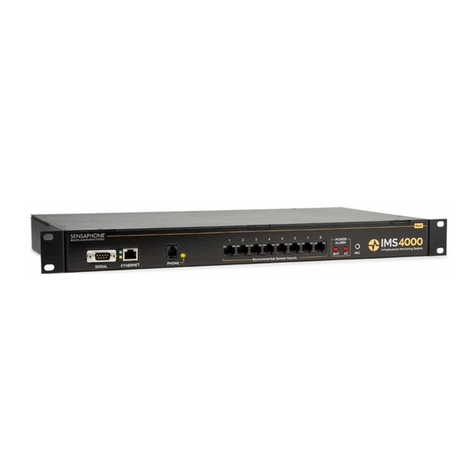
Sensaphone
Sensaphone IMS-4000 User manual

Sensaphone
Sensaphone IMS-1000 User manual

Sensaphone
Sensaphone IMS-4000 User manual
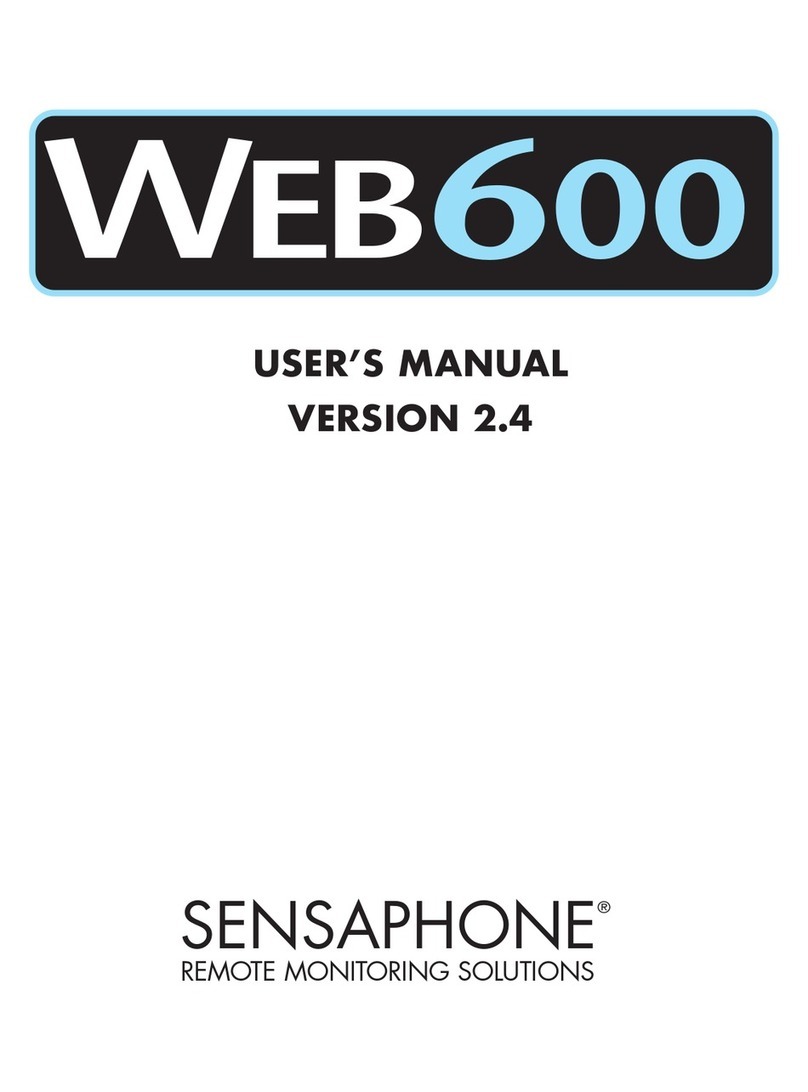
Sensaphone
Sensaphone WEB600 FGD-W600 User manual
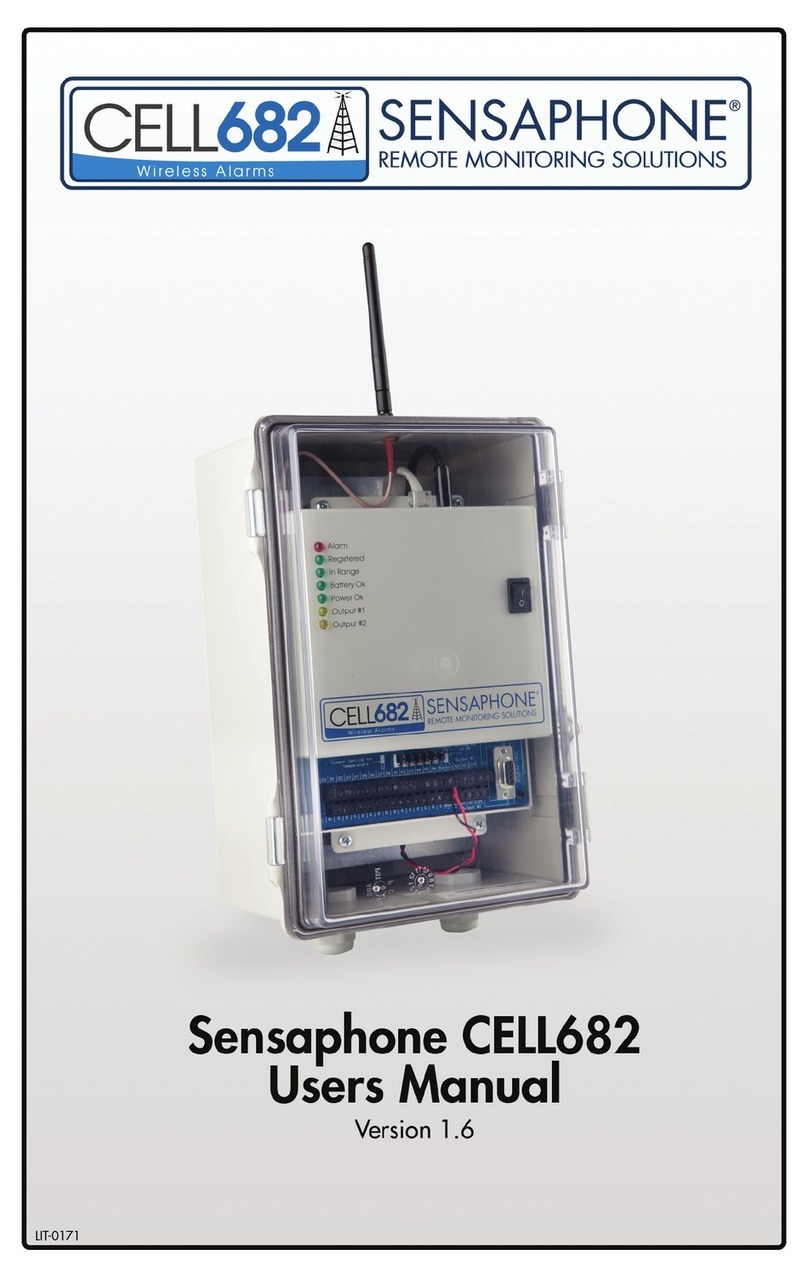
Sensaphone
Sensaphone cell682 User manual

Sensaphone
Sensaphone Sentinel Pro Assembly instructions

Sensaphone
Sensaphone SAT4D User manual
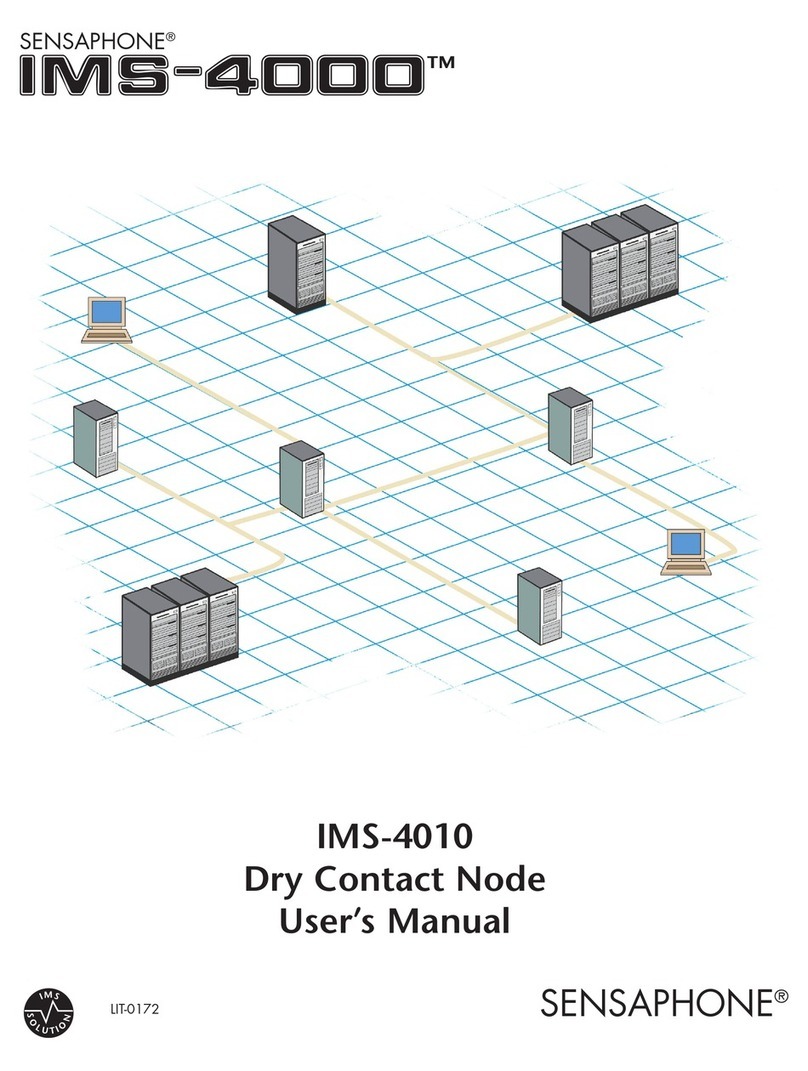
Sensaphone
Sensaphone IMS-4010 User manual

Sensaphone
Sensaphone 800 User manual

Sensaphone
Sensaphone 2000 User manual
